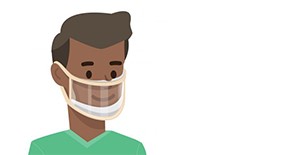The University maintains a Face Covering Policy to reduce transmission of COVID-19 and respiratory viruses.
As part of the University’s multi-layered strategy to limit the transmission of COVID-19, face coverings, particularly well-fitting, high-quality masks (e.g., N95, KN95, surgical mask) remain a useful tool in helping to limit the spread of COVID-19.
Requirements
Starting December 16, 2024, all personnel will be required to wear, at a minimum, a medical or surgical mask that covers the nose and mouth in all UW patient care areas.
UW Medicine medical facility personnel continue to follow the updated UW Medicine mask policy for health care workers. The facemask requirements in UW healthcare facilities are based on respiratory virus transmission (COVID-19, flu, and RSV) metrics. All patients, visitors, and families are strongly encouraged to wear a mask while in clinical spaces. Follow the mask signs posted upon entry to clinics.
UW Medicine medical facility personnel follow the UW Medicine mask and personal protective equipment policies.
Recommendations
In alignment with CDC and local public health guidance:
- Masks are strongly recommended when resuming normal activities after having COVID-19 or another respiratory illness, indoors when around others, for the next five days.
- Masks are strongly recommended after COVID-19 exposure, indoors when around others, until five days have passed from when you were exposed. In addition, follow the Public Health Flowchart for COVID-19 and Respiratory Virus Symptoms.
- Face coverings are strongly recommended in healthcare settings where they are not required.
- Immunocompromised individuals or those at high risk for severe illness in crowded settings may want to consider wearing a face mask.
Additional information
Face covering requirements will be reassessed as public health indicators change. Staying up-to-date with COVID-19 vaccinations is the most important layer of safety for preventing severe illness. In addition, follow the Public Health Flowchart for COVID-19 and Respiratory Virus Symptoms.
Frequently asked questions
If you or your family member are at high risk for severe illness, wear a well-fitted facemask or respirator, such as an N95, KN95/KFN94 or surgical mask (in order of protection), in indoor spaces. Respirators, including N95, KN95 and KF94, or a surgical mask provide greater protection than a cloth face covering. Note: UW employees that voluntarily wear respirators must receive this advisory information. You may also want to speak to your healthcare provider when making these decisions.
UW Human Resources provides information about individual accommodations for individuals at high risk for severe illness. Visit the UWHR website or contact your HR coordinator or AHR business partner.
We understand there are individuals who may not be comfortable with others around them not wearing masks. If this is the case for you, consider wearing a high quality well-fitted facemask or respirator, such as an N95, KN95/KFN94 or surgical mask (in order of protection).
Note: UW personnel who voluntarily wear respirators must receive advisory information.
1. Choose a well-fitted mask with greater protection than a cloth face covering.
Respirators, including N95, KN95 and KF94, and surgical masks provide greater protection than a cloth face covering. Note: UW employees that voluntarily wear respirators must receive this advisory information.
2. Make sure your mask fits snugly against your face.
Gaps can let air with respiratory droplets leak in and out around the edges of the mask.
- Use toggles or a knotting and tucking technique with medical/surgical masks to ensure a good fit.
- Using a mask fitter or brace over a disposable medical/surgical mask or a cloth mask can help prevent air from leaking around the edges of the mask.
- Check for gaps by cupping your hands around the outside edges of the mask. Make sure no air is flowing from the area near your eyes or from the sides of the mask. If the mask has a good fit, you may be able to see the mask material move in and out with each breath.
FAQs for University settings where face coverings are required
Individuals required to wear a face covering who have the following medical conditions or health risks may request an accommodation: a mental health condition, a developmental or cognitive condition, or a disability that prevents them from wearing a face covering. This includes, but is not limited to, persons with a medical condition for whom wearing a face covering could obstruct breathing, who are unconscious, incapacitated or otherwise unable to remove a face covering without assistance.
For University personnel requesting a medical or health risk accommodation, determination of the accommodation will be made on a case-by-case basis with the unit human resources representatives in coordination with the Disability Services Office (DSO), the unit, and EH&S. The UWHR website provides for more information about this process. Personnel may be required to provide documentation to substantiate their need for an accommodation.
Students seeking an accommodation should contact Disability Resources for Students (DRS) for determination of a medical or health risk. Accommodation will be made on a case-by-case basis through consultation with DRS.
Clear masks or cloth masks with a clear plastic panel are an alternative type of mask for people who interact with: 
-
People who are deaf or hard of hearing
-
Young children or students learning to read
-
Students learning a new language
-
People with disabilities
-
People who need to see the proper shape of the mouth for making appropriate vowel sounds (for example, when singing)
-
If you use this type of mask, make sure:
-
You can breathe easily.
-
Excess moisture does not collect on the inside of the mask.
-
You remove the mask before sleeping, since the plastic part could form a seal around your mouth and nose and make it hard to breathe.
The U.S. Food and Drug Administration (FDA) has approved a transparent medical mask, the ClearMask.